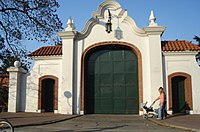Olivos, Buenos Aires
This article needs additional citations for verification. (January 2024) |
Olivos | ||
|---|---|---|
District | ||
CPA Base B 1636 | ||
| Area code | +54 11 | |
Olivos is a neighborhood in
Olivos is the municipal seat of Vicente López Partido, and it is also seat of the Argentina presidencial residence.
History



A well-known stop along the Buenos Aires-
The 1863 inaugural of the local railway station, one of Argentina's first, began attracting homeowners drawn by the area's tranquility and convenient access to the rapidly growing capital and, in 1897, the Church of Jesus of the Olive Trees was consecrated. A 1905 edict subdivided San Isidro Partido in two, creating the modern Partido de Vicente López and designating Olivos as the seat.
Home to a growing upscale community by 1917, local businessman Rodolfo Negrete founded the city's first clinic and marina and, during the 1920s, the small marina was modernized and the city's streets paved. The opening of
The city became the focus of national attention in 1941 when, upon the passing of Carlos Villate Olaguer (a great-great-grandson of Viceroy Olaguer y Feliú's), a 35 hectares (86 acres) section of the family's local land was deeded to the national government for use as the president's official residence. Graced by a mansion of an eclectic,
The residence hosted the
Geography
Olivos is located on the western bank of the Río de la Plata, the world's widest river. The river is approximately 50 km (31 mi) wide at Olivos, and as such, Uruguay is not visible from ground level. However, Olivos (and this entire region of the Rio) do not have sandy beaches; the shoreline is relatively rocky. Comparable shorelines include those of the Great Lakes in North America. The city's topography is relatively flat. However, there are some ridges by the river towards the north, in the La Lucila neighbourhood.
The city is located about 22 km (14 mi) north of Buenos Aires, of which it is effectively a suburb, and 270 km (168 mi) south of Rosario. Montevideo , capital of Uruguay is 180 km (112 mi) due east of Olivos, across the river.
Climate
Olivos has an oceanic climate (Cfb). The city has comfortably warm summers and cool winters. Temperatures are noticeably more moderate than in places further inland, or even in nearby Buenos Aires, due to the lack of an urban heat island. Rainfall is fairly consistent throughout the year.
| Climate data for Olivos (1981–2010, extremes 1888–present) | |||||||||||||
|---|---|---|---|---|---|---|---|---|---|---|---|---|---|
| Month | Jan | Feb | Mar | Apr | May | Jun | Jul | Aug | Sep | Oct | Nov | Dec | Year |
| Mean daily maximum °C (°F) | 26.4 (79.5) |
25.4 (77.7) |
23.3 (73.9) |
20.4 (68.7) |
18.6 (65.5) |
15.6 (60.1) |
14.7 (58.5) |
15.2 (59.4) |
17.9 (64.2) |
19.9 (67.8) |
21.7 (71.1) |
24.5 (76.1) |
20.7 (69.3) |
| Mean daily minimum °C (°F) | 15.6 (60.1) |
15.3 (59.5) |
14.0 (57.2) |
12.2 (54.0) |
10.3 (50.5) |
8.8 (47.8) |
8.1 (46.6) |
9.1 (48.4) |
10.3 (50.5) |
11.8 (53.2) |
14.2 (57.6) |
14.9 (58.8) |
11.7 (53.1) |
| Average precipitation mm (inches) | 94.3 (3.71) |
93.2 (3.67) |
95.5 (3.76) |
85.3 (3.36) |
64.5 (2.54) |
57.9 (2.28) |
53.7 (2.11) |
52.9 (2.08) |
56.3 (2.22) |
86.3 (3.40) |
81.1 (3.19) |
92.2 (3.63) |
925.2 (36.43) |
| [citation needed] | |||||||||||||
References
External links
- Municipal information: Municipal Affairs Federal Institute (IFAM), Municipal Affairs Secretariat, Ministry of Interior, Argentina. (in Spanish)
- (in Spanish) Web site of Vicente López municipality, of which Olivos is part
